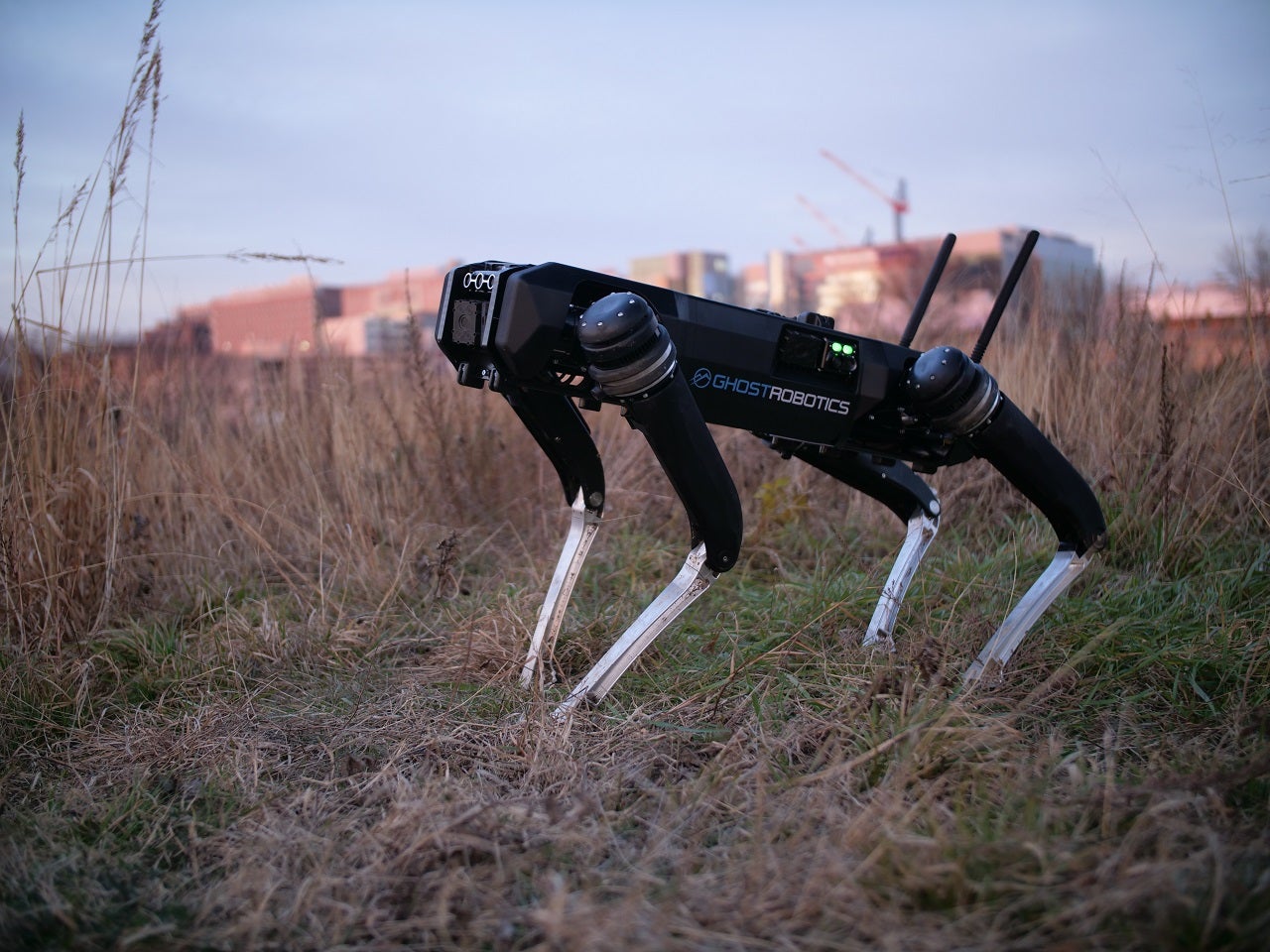
Service robots are deployed in various combat scenarios with the main objective of removing personnel from harm’s way. Such capability can give both strategic and tactical advantage. Drones, uncrewed ground vehicles (UGV) and even guided missiles are robots with weapons, but most people don’t consider them as such. Put four legs on the machine and things will change drastically.
“We envision that robotics would one day become a defender’s best friend and be deployed to undertake more risky and complex operations in tough terrains,” said the Singapore-based Defence Science and Technology Agency (DSTA) deputy chief of land systems Roy Chan in October.
Robot service dogs
Philadelphia-based Ghost Robotics’ quadrupedal uncrewed ground vehicles (Q-UGVs), or robot dogs, have attracted considerable attention in recent years, not least because the 325th Security Forces Squadron at Tyndall US Air Force (USAF) Base began using them on regular security operations.
The four semi-autonomous Vision 60 models the base operates each have 14 sensors, advanced multi-directional, thermal and infrared video capabilities and can operate for three hours of continuous run time on one charge. The robots carry out route checks and anomaly detection autonomously.
Ghost Robotics chief executive officer Jiren Parikh says: “The robot can be deployed for persistent security applications and it can also be put on a ‘plane for combat operations. It can be used in a forward operating base or a mobile operating base.”
Explaining the company’s concept, he says: “We have a robot dog with a ‘doghouse’ with edge processing on the dog and in the doghouse. We can retrofit the dog with any type of payload for any type of combat operation.”
Walking weapons

Ghost Robotics recently equipped its Vision 60 four-legged unit with Special Warfare Operations Research Development International’s custom-made, remotely-operated gun.
More than 20 national security customers currently use Ghost Robotics’ platforms, but Parikh says autonomous weapons are not where the main interest lies. Most of the company’s customers deploy the Vision 60 for chemical, biological, radiological, nuclear and explosives detection, reconnaissance and mapping.
“It’s primarily going to be a special force thing in the US, and we’re talking years by the time they get official approval. You’re not going to see any kind of operability of a weapon on our legged robots today. But I think in years down the road, you will.”
He says the only difference between Ghost Robotics and any ground, surface or air uncrewed systems with the option of weapon integration is that the Vision 60 walks on legs.
“People will get used to it just like they got used to the [General Atomics] Reaper-MQ predator drones carrying out operations,” Parikh adds.
The special-purpose unmanned rifle it is armed with has no autonomy nor integrated AI, and it is operated by a human in the loop. The concept was to create a walking quadruped and remove soldiers from the close combat environment.
Another US robot developer, Boston Dynamics, has a strict policy against weaponising its machines, including its quadrupedal Spot. However, if the shot is not fired from the back of the robot but it helps locate adversary targets for engagement, the machine can be considered just as lethal as its weaponised counterpart.
Spot participated in a two-day reconnaissance operation exercise with the French army last spring. Boston Dynamics vice president Michael Perry said in an interview that removing people from harm’s way is a justifiable use of the technology, but the company needs a better understanding of the military deployment of its systems.
Command, control and communications
DSTA recognises that changes in military procedures require soldiers to operate on a wide range of terrain and face unconventional threats. To equip its soldiers with the right tools, the agency developed its command, control and communications (C3) system prototype. The concept will leverage uncrewed ground and air systems for surveillance in urban combat to increase soldier survivability rates.
DSTA has partnered with Ghost Robotics to determine how quadrupedal robots could be used in defence settings. The partnership will see Ghost Robotics platforms paired with DSTA’s C3 system. The C3 allows for simultaneous control and monitoring of multiple uncrewed systems in harsh environments, but there is no intention of weaponising remotely-controlled platforms.
Most legged robots balance and navigate using AI-powered computer vision ad force sensors. The information processing speed of such proprioceptive methods can fail on slippery surfaces and other challenging environments.
Parikh says although the Vision 60 is equipped with sensors and vision capabilities, it only uses direct motor sensing when navigating difficult terrain.
“We have a very large motor and very little gearing. At a small scale, we can keep the actuators very transparent,” he explains. “We don’t have to put a lot of gearing or drive train on the robots to lift heavy payloads. It is operating at two Kilohertz [2,000 instructions per second].”
That means anytime the Vision 60 slips, is pushed or leans on anything, its 12 motors sense and correct those at two Kilohertz. This is similar to how most living species operate. Motor sensing allows the robot dog to balance itself on icy surfaces, walk in tall grass, high waters or climb debris hills.
According to GlobalData forecasts, the robotics industry was worth $45bn in 2020, and by 2030, it will have grown at a compound annual growth rate (CAGR) of 29% to $568bn. GlobalData expects every segment of the robotics market to grow over the next decade. Industrial robots will function as a growth driver as innovation in the segment will spill over to other areas.



